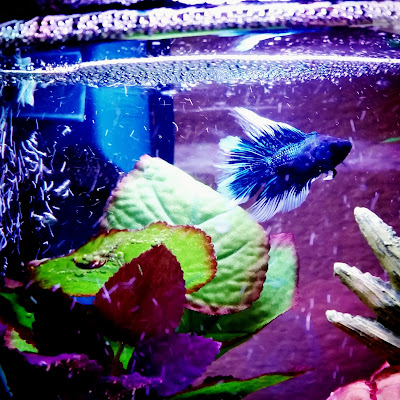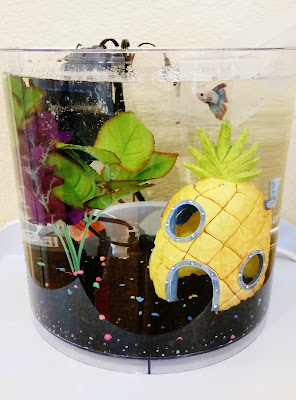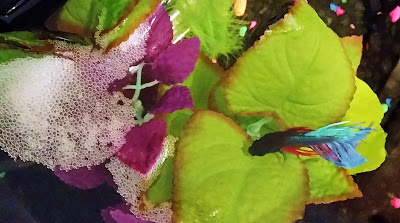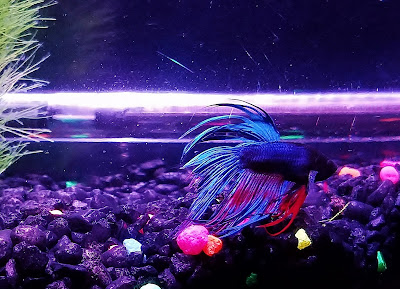(AKA What Do I Need to Know About Betta Fish Care?)
Betta fish, also known as betta splendens or Siamese fighting fish, are incredibly popular with both first-time pet owners and and long-time fish lovers. While they're known for their vibrant colors, long flowing tails, and interesting personalities, most people don't know that bettas need more than a bowl to live in and pellets to eat. Follow this straightforward FAQ-style guide to owning a happy and healthy betta!
Question: What Do I Need for My Betta Fish?
Check out this shopping list of necessities for your betta fish:
- Tank: Your betta fish tank size should be a minimum of 3 to 5 gallons. A simple rule of thumb for small freshwater fish is 1 gallon of water per 1 inch of fish, and bettas grow to about 2.5 inches long. Also, the aquarium needs a lid/hood because bettas are suicide jumpers. (FYI PetSmart carries their own brand called the Top Fin 5.5 Gallon Aquarium Starter Kit that comes with a lighted hood, filter, net, and thermometer.)
- Decorations: Bettas like to have places to hide and explore, so provide aquarium decor and silk plants (nothing sharp that might rip fins). Live plants are great, but like any garden, they require time and care. (Petsmart is where I found more natural-looking artificial plants.)
- Heater: If your room does not maintain a steady 75-82°F 24/7 all year round, you need a heater for your betta fish (rated for your tank size). Otherwise, he may become sluggish, stop eating, or become ill. Why doesn't my betta fish swim around much? Because he's cold. (((=_=)))
- Thermometer: Sometimes heaters fail. How can you be sure? Get a super cheap thermometer.
- Filter: Do betta fish need a filter? Yes please! Trust me - your tank will have clearer water for longer periods of time. When my starter kit filter failed, I switched to the terrific Aqueon QuietFlow filter (rated for my tank size) because of its adjustable nozzle and flow rate.
- Power Strip: Your tank is going to have 2 to 3 plugs and the nearest power source may not be super close, so get a long, multi-outlet power strip.
- Net: Pretty self-explanatory, but it's nice to have one for transporting your betta or removing uneaten food.
- Water Conditioner: Tap water contains chlorine which will kill your fish, so use Seachem Prime Water Conditioner (the aquarist's favorite choice) for all your water changes.
- Gravel Vacuum or Siphon: This is single-handedly my favorite tool for fish keeping. No more dumping out the entire tank and splashing dirty fish waste everywhere during water changes. You need this Python siphon (rated for your tank size).
- Empty Water Jug: You can buy a gallon of distilled water from your grocery store or get a larger water jug for bigger tanks.
- Bucket: You'll need something to contain 3 to 5 gallons of dirty water from the aquarium.
- Algae Scrapper: I personally like regular ol' sponges because they're easy to get into corners, but you also get magnetic or handled ones. Choose one based on if you have an acrylic vs. glass tank.
- Food: Go for the Hikari Betta Bio-Gold pellets. It'll take your fish forever to finish a package, so there's no reason not to get the extra good, color-enhancing stuff.
- Medication: Don't wait until your betta fish gets sick to get meds because any delay may be too late. For your first aid kit, you should keep some aquarium salt and Seachem ParaGuard (good broad-spectrum stuff) on hand.
 |
| Didn't know it took so much stuff to keep me alive, eh? |
Question: How Do I Set up a Betta Fish Tank?
- Once you have all your supplies, choose a good location that can support the weight of a full aquarium (10 to 12 pounds per gallon) and an electrical outlet near by. Do not let direct sunlight hit any part of your tank or else algae will aggressively take over.
- Use plain water to rinse the tank and all the accessories (e.g., gravel, decorations, filter, heater, and thermometer). Don't use soap or cleaning agents because your fish can't, well, breathe soap.
- If you bought gravel, add 1 to 2 pounds of gravel for every gallon of tank water. Fill the aquarium 1/2 full of room temperature tap water.
- Install your heater, filter, and thermometer according to their instructions. (Don't turn them on yet.) Your tank hood should have cutout panels that will fit around the various instruments.
- Place the heater vertically and low in the tank or horizontally at the aquarium bottom so that it doesn't have to be turned off during water changes.
- Betta fish hate fast currents so you may have to cover the intake and baffle the output (tutorial to come).
- Place the decorations in the tank to hide the heater and filter. Then fill the rest of the aquarium with water up to 1 to 2 inches from the top (so your betta fish can come to the water's surface for air).
- Make sure to add the appropriate amount of water conditioner (also known as dechlorinator) into the tank. Now you can turn on all the equipment.
- Let everything (excluding the lights) run for a full day until the temperature stabilizes to 75-82°F.
Do I Need to Cycle My Betta Fish Tank?
Cycling simply refers to the process in which a new tank grows beneficial bacteria that breakdowns toxic ammonia (from fish waste) into less harmful chemicals. Fish lovers are very passionate about making sure you only introduce new fish to
mature, cycled aquariums, which can take 6 to 8 weeks or more. However, small tanks (less than 5 gallons) are notoriously hard to cycle because there's just not a lot of surface area to grow beneficial bacteria. Therefore, your job is to change the water at least once a week to make sure ammonia and other chemicals don't build up to harmful levels (since the bacteria aren't there to do it).
 |
| New betta fish acclimating in a properly setup aquarium |
Question: What Do I Do When I First Bring My Betta Fish Home?
These instructions are for acclimating your betta fish to a aquarium in which he is the first and/or only resident. If there are other fish already in the tank,
quarantine the betta fish for 2 to 4 weeks first and then follow these steps.
- Turn off lights in the aquarium and surrounding area to minimize stress for the fish.
- Open the betta fish's bag and throw out all but about 2 inches of water. (If the betta came in a cup, pour the fish and 2 inches of water into a quart-sized plastic bag.) Let the fish bag float at the top of the aquarium for 15 to 30 minutes to equalize the water temperature. It helps to clip the bag to the side of the tank to prevent accidental spillage.
- Add a small amount of the aquarium's water to the bag and let the fish get used to it for 10 minutes. Repeat this at least 3 more times until the bag holds mostly aquarium water. (One betta owner even says she takes 2 to 6 hours with this step.)
- When you're ready, use the fish net to move your betta from the bag into the aquarium. Avoid putting any pet store water into the tank because it may contain pathogens.
And that's it! I usually wait a day before feeding my betta to give him time to get used to his new environment.
Question: How Do I Clean a Betta Fish Tank?
The great thing about having a gravel vacuum or siphon is that you don't have to relocate your betta and decorations, dump out the whole tank, and put everything back together. Just follow these 5 easy steps (or less) for your weekly partial water changes:
- Turn off your filter if the output flow will splash too much during the water change. Turn off the heater if the water level will drop below its proper level of operation (that's why it's less hassle to mount them as low in the tank as possible).
- If algae is present, use the algae scrapper to scrub down the walls and decorations. Note: algae needs food and light, so I rarely need this step since no direct sunlight hits the tank, the hood light is on for less than 8 hours a day, and no uneaten food is allowed to remain.
- Use the gravel vacuum to suck up fish waste and food from the bottom of the tank. Put the tube (larger diameter end of the siphon) in the tank and the hose (smaller diameter end) in the bucket for dirty water. To start the vacuum, I use this very simple technique (no starter bulb needed), and then follow this tutorial to clean the gravel. While using the siphon, clean 1/3 to 1/2 of the gravel. Also only remove 10 to 25% of the tank water (don't want to shock your fish too much with new water).
- Fill the empty water jug with tap water at approximately the same temperature as the tank's current water (your hand is a good judge of temperature). Don't forget to add the water conditioner. Pour the new water into the aquarium, stopping 1 inch or more from the top of the tank.
- Rinse out the dirty water bucket and siphon, wipe the outside of the tank, and you're done!
Remember: Never use soap or household cleaning agents on the tank and its accessories. If you need to disinfect a tank of pathogens or remove stubborn algae,
bleach is your friend.
 |
| Bubble nests are a good sign that your male betta fish is happy with his water quality and food |
Question: How Do I Feed a Betta Fish?
A) How Much Do I Feed a Betta Fish?
Everyone warns you not to overfeed your betta fish, since these little piggies will happily eat themselves to death.
Hikari Betta Bio-Gold packages give these exact instructions: For a betta with a 1.5-inch long body (not including the tail), feed three pellets and add 1 pellet per 1/4 inch of additional length. For my 2-inch long betta, that means he gets a total of 5 pellets each day. A properly fed betta fish will have a softly rounded body, so if your betta fish starts developing a beer gut, might be time to go on a diet. In fact, they can easily survive without food for several days (life is much harder in the wild), so no need to get a pet sitter if you're gone for the weekend.
B) How Often Should I Feed a Betta Fish?
Once or twice a day is fine. During meal time, feed your fish one pellet at a time (float the pellet at the surface) and make sure each pellet is completely consumed (sometimes they'll trick you and spit it out a few seconds later). Remove any uneaten pellets afterwards. Also, fast your betta fish one day a week to prevent constipation.
C) What Should I Feed My Betta Fish?
Variety is the spice of life, so besides their staple of pellets, consider treating your betta once or twice a week to freeze-dried or frozen bloodworms, brine shrimp, daphnia, or tubifex worms.
P.S. When your betta first comes home, it may take 2 to 5 days for him to get used to new food (aka he may spit it out and refuse to eat it). Just keep trying each day and eventually hunger will win him over.
 |
| Betta fish hanging out with his tank mate, a zebra nerite snail |
Question: Can Betta Fish Live with Other Fish?
Trust me, your betta will not be lonely. They are solitary and territorial by nature, so they will attack any other betta or betta-looking fish in the tank. Some bettas with a calmer disposition can successfully live in community tank, but personalities can be hard to tell when they're in the pet store cup so be prepared to yank out the bully if needed. For example, one of my bettas merrily attacked my peaceful neon tetras, cory catfish, and ghost shrimp (all listed as excellent
betta fish tank mates), so he got to live out the rest of his days in his own private penthouse.
Finally, make sure your tank is big enough to house any tank mates. A great online tool is the
AqAdvisor aquarium stocking calculator.
 |
| Crowntail betta fish with frayed tail from tail biting :( |
Question: What Does a Healthy vs. Sick Betta Look Like?
A) What Should I Look for When Buying a Betta Fish?
A happy, healthy betta is active, alert, colorful, and reacts to stimulus. No frayed fins or ripped tail, no scales popping out like a pine cone, no eyes popped out, no spots or fungus on body, the gills look healthy, and so on.
B) Is My Betta Fish Sick? What's Wrong with My Betta?
A sick betta is sluggish, not hungry, acts funny, and/or looks abnormal in some way. Check out these great websites with
lists of symptoms and
pictures to diagnose your betta and get detailed info on treatment options. If your betta doesn't live by himself, you may need to
setup his own quarantine tank/tub.
C) How Do I Humanely Euthanize a Betta Fish?
The fact of life is that not every betta can be saved despite your best efforts. Don't let him suffer more than necessary. Toilet flushing or freezing a fish can take a long time before death and lead to suffering. Decapitation or blunt trauma is swift and effective, but can be distasteful. Consider
these options for euthanization, including my preferred method of using
clove oil.
And there you go! Betta care from A to Z. If you have more questions, please comment below and I'll be happy to help.






1 comment:
nice post
Post a Comment